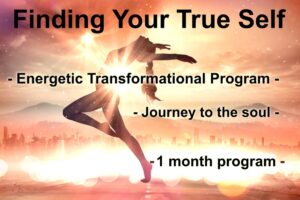
Paths and Styles Of Yoga
Let's begin with: Paths Of Yoga
Originally, in history, there where 5 paths of Yoga.
Karma Yoga – Yoga of action.
Jnana Yoga – Yoga of knowledge.
Bhakti Yoga – Yoga of devotion.
Kriya Yoga – Yoga of energy.
Raja Yoga – Royal Yoga / 8-limb Yoga.
A person would choose one (or be exposed to one) of these pathways of Yoga and dedicate their lives to walking that particular path. All Yoga paths lead to the ultimate unity of the finite with the infinite. Of uniting with universal consciousness.
The most integrated Yoga of the 5 paths was (and is) Raja Yoga. Raja Yoga was also a path that a house holder/lay man could follow as it was about integrating Yoga into everyday life.
In the past the other 4 paths required gurus, renunciation from living a householder’s life and total dedication to the path of Yoga.
These 5 Yoga paths are still practiced today with Raja Yoga being the most followed.
Raja Yoga
Raja Yoga is made up of 8 branches or 8 limbs.
The first two limbs (Yamas and Niyamas) are ethical practices which you take on simultaneously and consistently throughout your life.
The other branches are more like steps that have to be followed in that the one branch leads to the other until eventually you reach the final branch and that is liberation/ bliss.
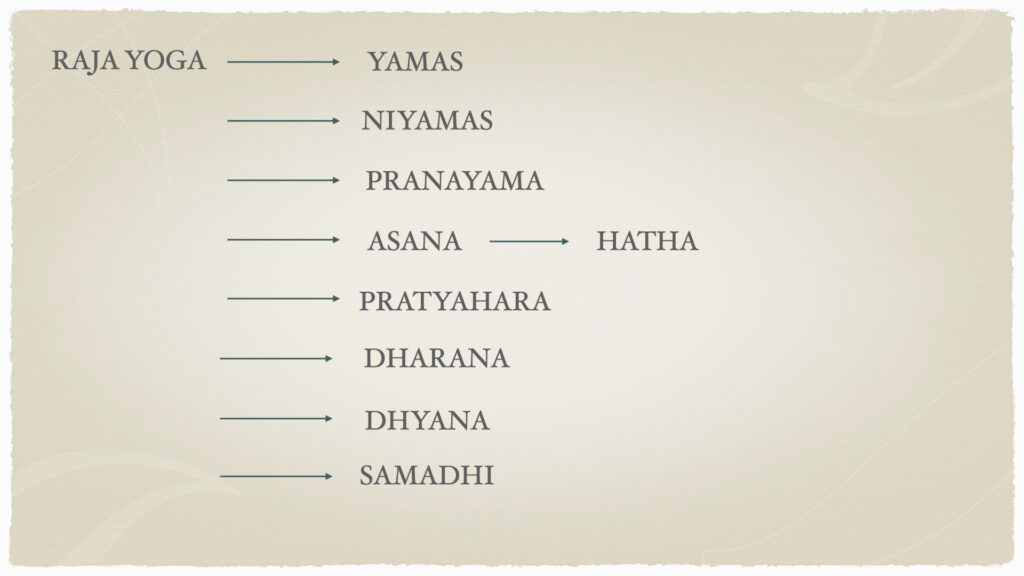
Here are the 8 branches / limbs in order:
1. Yamas – Our behaviours and ethical standards:
Ahimsa: non violence, non injury.
Satya: truthfulness.
Asteya: non-stealing.
Brahmacharya: chastity, sublimation of sexual energy.
Aparigraha: non -covetousness, non-accepting of bribes, non-hoarding.
2. Niyamas – Self discipline:
Saucha: purification practices (external and internal cleansing).
Santosha: contentment.
Tapas: austerity, determination, and dedication.
Swadhyaya: study of spiritual scripture and concept and study of the self.
Ishwara Pranidhana: surrender to a higher power, letting go of the ego.
3. Asana – Posture or pose or physical movement
4. Pranayama – Control of the breath and vital energy
5. Pratyahara – Withdrawal of the senses from the external
6. Dharana – Concentrating the mind
7. Dhyana – Meditation
8. Samadhi – Super-conscious state, transcendence of the self, merging with universal consciousness, bliss.
Styles of Yoga
The Yoga we know in the Western world stems from the Asana branch of Raja Yoga.
Asana is the pose / posture / movement / action of the physical body for positive health, mind, physical and emotional changes.
Asana is where Hatha Yoga comes from.
All other Asana Yogas styles stemmed from Hatha Yoga. So Hatha Yoga is the original Asana Yoga.
The others styles which you may be familiar with are:
– Vinyasa
– Iyengar
– Ashtanga
– Bikram
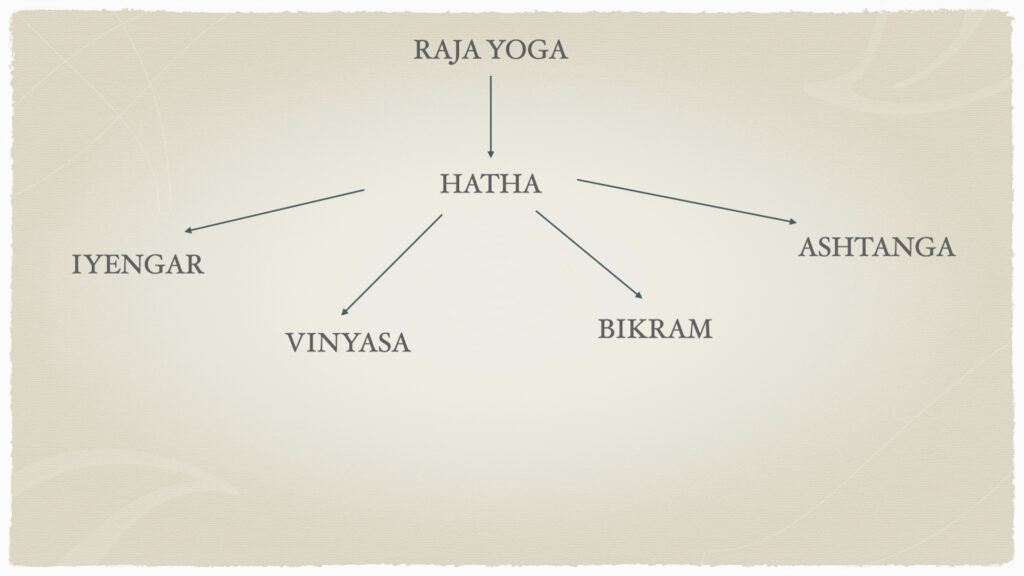
These Yoga styles are what you predominantly see being practiced on the mat in a Yoga studio or gym.
All of these more modern styles of yoga also follow the 8 limbs of Raja Yoga, and the idea is to integrate the Raja path into daily life beyond the mat.
Heres a quick review what each Yoga style is about:
Hatha – Balancing the body and mind. Slow paced class focusing mainly on postures. ’Ha’ represents sun energy, and ‘tha’ moon energy.
Vinyasa – Flow and linking poses and postures together. Focusing on the transitions from one pose to the other in a fluid motion.
Iyengar – A meticulous yoga, with most of its focus being about perfect alignment. Usually using any form of equipment or apparatus to get into the perfect alignment.
Ashtanga – Power yoga that is always performed with the exact same poses in the exact same order with holding the postures for 5 to 10 breaths.
Bikram – 26 Poses and 2 breaths that are performed in a specific sequence in 40’C hot rooms.
A More Modern Concept
Coming back to the 5 main paths of yoga.
Karma Yoga – Yoga of action.
Jnana Yoga – Yoga of knowledge.
Bhakti Yoga – Yoga of devotion.
Kriya Yoga – Yoga of energy.
Raja Yoga – Royal Yoga / 8-limb Yoga.
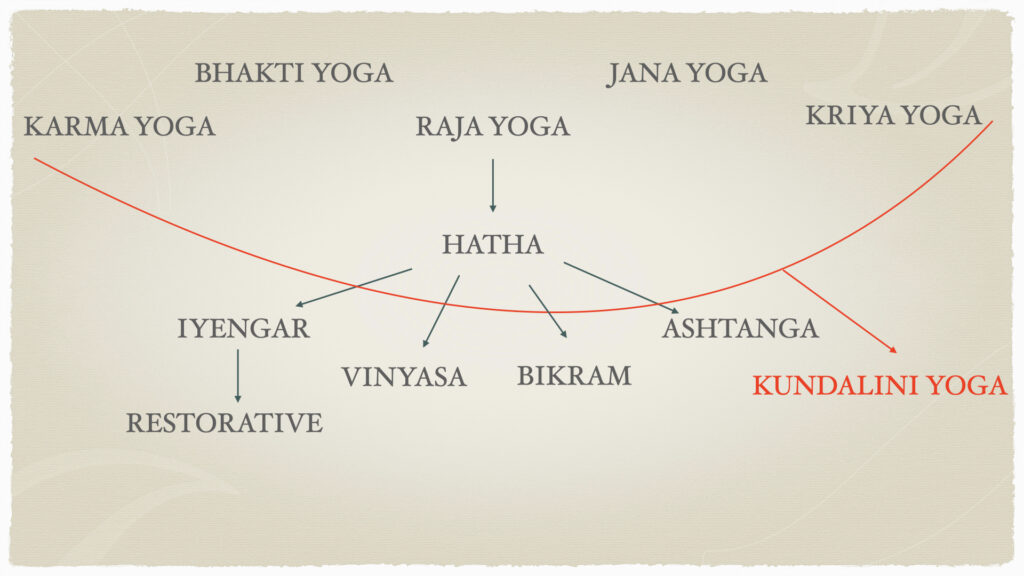
In the past it was believed that you only need to take one of these for libration, but a more modern approach is to follow all 5 paths simultaneously for a complete Yoga. For example: What is the point of giving of service through action (as in Karma Yoga) without working on the mind or purifying the body.
So how do you take on all of these paths simultaneously?
Answer 1: Study the different paths and chose parts of them that you wish to take on for your personal practice.
Answer 2: Kundalini Yoga.
Kundalini Yoga is a new Yoga in comparison to the lifespan of the 5 main paths. Kundalini Yoga has all 5 of these paths blended into the practice.
Kundalini Yoga is first a Raja Yoga, which means full lifestyle integration and steps to follow.
The practice has a devotional side where a participant takes on daily sadhana and daily kriyas for 40 to 120 to 1000 days of consistent practice.
There is study and leaning of spiritual concepts as well as experience and knowledge through embodiment of practice. Kundalini Yoga is very similar to Kriya Yoga in that it uses energy as its primary transformational tool. Lastly Kundalini Yoga is about taking action for the greater good of the participant and for the greater good of humanity. We also practice seva, or selfless service. This is acts of kindness and generosity that neither demands, nor expects, reciprocation.
Other Yogas
A range of other Yogas have been established that bring the merging of the finite with the infinite using one element as a tool for example:
Laya Yoga – Merging the finite with the Infinite. The use of sound, mantra, rhythm and visualization with a sensitivity to its subtle structure. Often practiced in groups.
Mantra Yoga – A discipline using sounds, often chanted, that protect, project and alter the state of the mind.
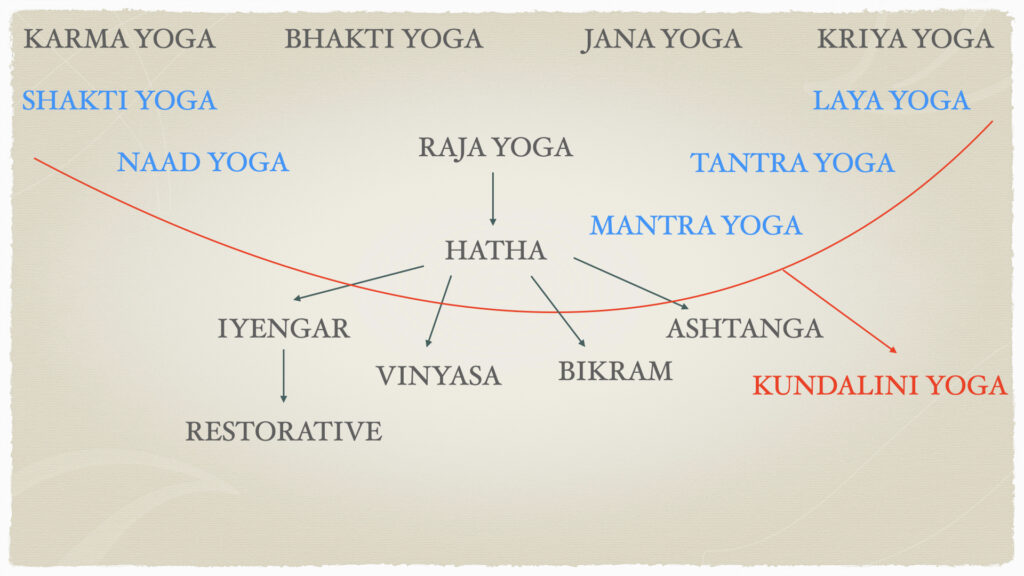
Naad / Nada Yoga – The discipline of the inner sound, the primal vibration. It uses breathing, rhythm, and sound to synchronize the biochemistry of the body and the brain.
Shakti Yoga – Within us exist two aspects. Consciousness, also known as the principle of Shiva, and Energy, also known as the principle of Shakti. A practice that uses will, movement, action and energy that develops the feeling of vitality, potency and increased ability in the individual.
Tantra Yoga -3 types: White, Red & Black. White Tantra is an ancient group meditation practice that can help you release deep subconscious blocks and heal your body and soul working with your own sexual energy.
Kundalini Yoga – Kundalini Yoga uses components of all of the above other Yogas. The whole purpose of Kundalini Yoga is to fast track, so any technique or tool that will do this will be part of the Kundalini Yoga discipline.
(Note: Kundalini Yoga does not include Vinyasa, Ashtanga, Iyengar, Bikram, Yin or Restorative Yoga.)
Some More Modern Yogas
There will always be evolution and new Yogas brought into fill a gap or need. Two of these are Yin Yoga and Restorative Yoga.
Yin Yoga is a Yoga where one gets into a posture and then relaxes into the posture for the purpose of working on the connective tissue of the body. It is a deep stretch with relaxation. You do not need to be concerned about perfect posture, but rather what works best for your individual body ability and needs.
Restorative Yoga is a healing yoga that came from Iyengar Yoga. Iyengar Yoga is extremely intense in its postures, so the Guru Iyengar developed Restorative Yoga that would be practiced between the Iyengar practices as a way to relax, restore and heal quickly. Restorative Yoga is placing the body in a posture that is supported by equipment (like cushions and bolsters) so that no effort has to be made by the participant. Restorative is for deep healing and relaxation.
Yin and Restorative do not follow the Raja Yoga path. They are there for the physical, mental and emotional body only.
The next three are NOT yogas. They are highly enjoyable and tap into some elements from Asana and Pranayama but they do not create the unity of finite to infinite, so are not true Yogas.
– Laughter Yoga
– Acro Yoga
– Arial Yoga / Flying Yoga
How to Chose
The benefits and effects of Yoga depends on the Path or Style of Yoga practiced.
Some focus more on the physical body, some focus more on energy, some focus mainly on sound….. Yet if your ultimate aim is to liberate yourself from yourself and the suffering of the world then I suggest you chose a Yoga that will offer full body embodiment, fully transform the mind, work the energetics of the body, raise your consciousness with a flow over into your daily life.
All of the Yogas that come from / include Raja Yoga will do this.
If you want to fast track this process then I suggest Kundalini Yoga.
Yoga is about bringing in a bit more compassion, kindness, understanding, resolution, awareness and improvement, so enjoy your personal Yoga discovery.
Article by Nicola (Sita Amrit Kaur) July 2021
Ready to expand your consciousness?
Ready to release those blocks that have kept you stuck?
In a transition and wanting to know how to navigate it?
There is no time like NOW to do the work on yourself!
Join the 1 Month integrative program.
